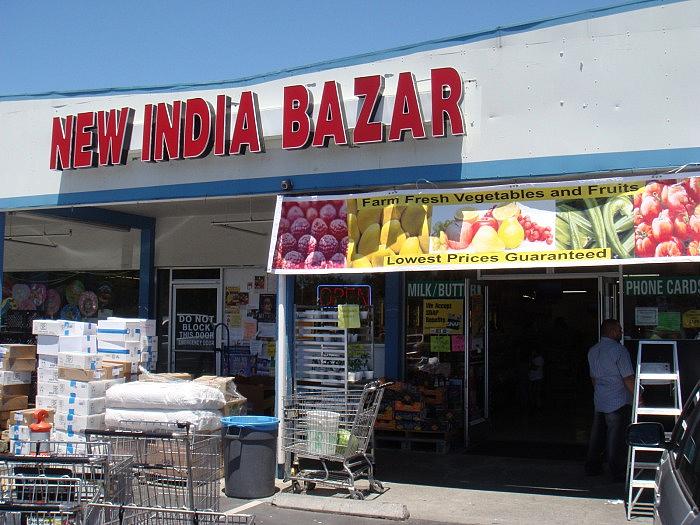Ethnic grocery stores are a measure of health for diverse neighborhoods

Grocery stores such as New India Bazaar and Trinethra provide staples and cultural lifelines for the South Bay’s Indian community.
(Photo via Srishti Prabha)
When I was living in Boston, part of planning my trips home would involve calling my mother and curating a menu of Bihari dishes that I wanted waiting for me upon my arrival. Of course, I am impartial to my mother’s cooking, but that wasn’t the only reason for my demands. In Boston, I didn’t have access to the ingredients I would need to recreate her food. My immunity declined and it was then that I realized my health was dependent on my Indian diet.
The broader link between healthy ingredients and a community’s well-being is one reason grocery stores are the cornerstone of any neighborhood. They work as a measure of health of a community. A 2015 study by Health Affairs found a negative association between food insecurity and health outcomes in America.
In my three-part multimedia series, “Masala Heroes,” I will take a deep dive into ethnic grocery stores, which have provided an essential and consistent service through the course of the pandemic.
Food insecurity has far-reaching effects that transcend healthy eating. In a 2016 study on gentrification in Toronto, the Journal of Urban Health reports that ethnic identities and the food security they provide can help mitigate gentrification, which can displace entire communities and put their health at risk.
Another article in the Washingtonian links the locations of Whole Foods with an effort to gentrify specific communities, by placing socioeconomic barriers on existing communities: Healthy foods become inaccessible.
Dollar Tree, a store with no fresh produce and a common replacement for grocery stores, dominates lower-income communities of color — a practice known as supermarket redlining. Institute for Local Self-Reliance reports that the prevalence of Dollar Tree stores results in poorer health in those communities. As a resident of San Jose, I have personally experienced these shifts.
But for this project, my concern lies with the place I buy my produce most frequently — my local Indian grocery store. How has COVID-19 made its mark on the health of South Asian grocery stores, fiscally and physically? What challenges did these stores face and how did they address them?
The first article in the series will set the stage by explaining what local ethnic grocery stores offer during and outside of the pandemic. I’ll explore the connection between cultural food security and the health of the South Asian community in the South Bay. For the freshest bhindi, kerala and lauki at the best price, Desi communities look no further than San Jose staples: New India Bazaar and Trinethra. Heritage vegetables, some that the general U.S. population may have never heard of, are a large component of cultural health for South Asian families. Generational knowledge on health and culture is passed down through meals laced with spices and vegetables specific to the diet of a cultural region.
The mom-and-pop ethnic grocery stores are more than just a place for fresh food. They are our lifelines to our culture and our communities in the Bay Area; a place where you can walk in and be greeted with, “Is bar ma ne bheja?” (“This time your mom sent you for the groceries?”) The manager knows that my family rotates grocery trips.
India Currents, itself, is inextricably interlinked with grocery stores in the Bay Area. When it began as a print magazine 30 years ago, it was sustained by grocery stores and the space they afforded.
My second article will be heavier on data to provide an in-depth look at ethnic grocery stores as businesses. Owners with stores in multiple locations will be interviewed on the financial repercussions of COVID-19 on their business. The conversations will help me humanize the federal, county, and state efforts to sustain small businesses and provide insight on whether those efforts were successful. Some other questions I hope to answer are: Were groceries less or more attainable? Did prices increase? What did it cost for their business to adapt to COVID guidelines? How easy or difficult was it to change protocols to comply with county standards? Of the 50 Desi grocery stores in the Bay Area, how many are still active at this point in the pandemic?
For my third article, I hope to interview ethnic grocery store employees and hear about the nature of their work and the rates of COVID-19 in their communities. The article will address employees’ access to health care and savings accounts, and in the case of reduced work or health concerns from COVID-19, their experiences and biggest fears. I would like to check public county records to see if there is data on the rates of COVID-19 within grocery stores. These employee narratives, as essential workers without a yearly salary and benefits such as health care and retirement accounts, should serve as a reminder of the people our South Asian community leans on in a time of need and what greater equity might look like for them.

